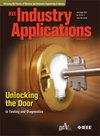Implementation of Leader Development Models for Prediction of Insulation Flashover in Lightning Studies
IF 4.5
2区 工程技术
Q2 ENGINEERING, ELECTRICAL & ELECTRONIC
引用次数: 0
Abstract
The prediction of the behavior of long air gaps and insulators, when stressed by fast-front overvoltages of non-standard waveshape, is crucial for evaluating the effects of lightning to power systems. This can be achieved in an accurate manner by applying leader development models (LDMs), accounting for the associated physical processes. This work contributes to LDM application to different methodologies/techniques used for the simulation of lightning strikes to power systems, and hence, for insulation coordination studies. This is achieved by identifying and discussing important features related to LDM implementation in a generalized manner not tied to a specific methodology and a specific LDM. Finite Difference Time Domain (FDTD) and ATP-EMTP implementations are introduced to investigate the effects of these elements. They are then employed to assess the lightning performance of a 150 kV single-circuit overhead power line. For this purpose, the minimum lightning currents causing shielding failure flashover and backflashover to the line are computed by means of the two aforementioned simulation methods. Results are compared and discussed considering the differences between methods. For the shielding failure case, identical results were obtained. Differences from <1% up to ∼10% were found for the minimum backflashover current, and up to <5% for the backflashover rate.雷电研究中绝缘闪络预测先导发展模型的实现
长气隙和绝缘体在非标准波形的快速前过电压作用下的行为预测,对于评估雷电对电力系统的影响至关重要。这可以通过应用领导者发展模型(ldm)以准确的方式实现,并考虑相关的物理过程。这项工作有助于LDM应用于不同的方法/技术,用于模拟电力系统的雷击,从而用于绝缘协调研究。这是通过以一种通用的方式识别和讨论与LDM实现相关的重要特性来实现的,而不依赖于特定的方法和特定的LDM。引入时域有限差分(FDTD)和ATP-EMTP实现来研究这些元素的影响。然后用它们来评估150千伏架空单回路电力线的雷电性能。为此,采用上述两种模拟方法计算了引起线路屏蔽失效、闪络和反闪络的最小雷电电流。考虑到不同方法的差异,对结果进行了比较和讨论。对于屏蔽失效的情况,得到了相同的结果。最小反闪电流的差异从<1%到~ 10%,反闪率的差异高达<5%。
本文章由计算机程序翻译,如有差异,请以英文原文为准。
求助全文
约1分钟内获得全文
求助全文
来源期刊

IEEE Transactions on Industry Applications
工程技术-工程:电子与电气
CiteScore
9.90
自引率
9.10%
发文量
747
审稿时长
3.3 months
期刊介绍:
The scope of the IEEE Transactions on Industry Applications includes all scope items of the IEEE Industry Applications Society, that is, the advancement of the theory and practice of electrical and electronic engineering in the development, design, manufacture, and application of electrical systems, apparatus, devices, and controls to the processes and equipment of industry and commerce; the promotion of safe, reliable, and economic installations; industry leadership in energy conservation and environmental, health, and safety issues; the creation of voluntary engineering standards and recommended practices; and the professional development of its membership.
 求助内容:
求助内容: 应助结果提醒方式:
应助结果提醒方式:


